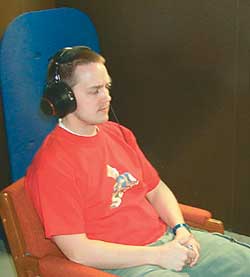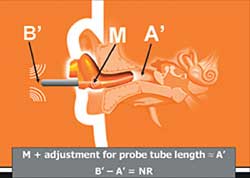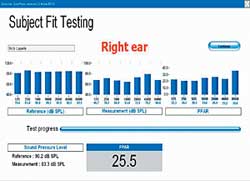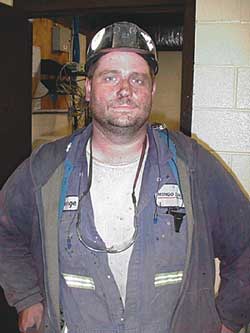Fit Testing Ear Plugs
New technologies are emerging that will provide easy individual fit testing of HPDs.
- By Lee D. Hager
- Jun 01, 2006
ONE of the biggest barriers to effective use of hearing protection devices (HPDs) as the last line of defense against noise in the workplace is that there has never been a good way to test performance. How can we trust PPE if we don't know how well it works? Laboratory rating systems do a good job of measuring the protective capability of HPDs to block noise, but study after study has shown that real people working in real noise conditions rarely achieve the levels of protection that would be expected based on the laboratory testing reflected in the noise reduction rating (NRR) label on the HPD package.
One response to this problem is to arbitrarily "derate" the NRR. When comparing the effectiveness of HPDs to noise controls, OSHA instructs its inspectors to subtract 7 dB from the labeled NRR to correct for the different kinds of noise used in the lab as opposed to field measurements, then cut the remainder in half. Thus, an NRR of 29 gets "credited" the same as a noise control giving 11 dB of reduction. NIOSH takes a different derating approach, based on the type of protective, in its 1998 Criteria Document (Occupational Noise Exposure: Criteria for a Recommended Standard, www.cdc.gov/niosh/98-126.html).
While these approaches reflect a more conservative way to estimate HPD performance, they do not resolve the fundamental difference between laboratory rating and actual field performance. Some workers will use an HPD with an NRR of 29 and get 32 to 33 decibels of protection; others may get 12 to 15; still others, no protection at all. If it is important to know how well HPDs work on individuals, the only way to make that determination is to test HPDs on individuals.
A workshop held at the recent annual conference of the National Hearing Conservation Association (www.hearingconservation.org) showcased some innovative technologies to address this issue.
FitCheck™
Currently, one of the most widely used systems for individual fit testing of HPDs is FitCheck, developed by Michael & Associates (www.michaelassociates.com, click on FitCheck). This process simulates the laboratory approach of testing the quietest test tone a subject can detect with ear plugs in and testing again with ear plugs out. The difference between the two sets of measurements, called real ear attenuation at threshold (REAT), is an estimate of the protection provided by the ear plugs for the individual and the HPD fit under test.
FitCheck takes this process out of the controlled laboratory sound booth and places it under a large volume headset. Test tones similar to those used for industrial hearing tests are used, and the subject is asked to lodge a response (typically, to press a button) when the test tones are just audible.

The FitCheck system is PC-based and portable, and it allows for individual fit testing in most environments. Because it is a threshold response system (subjects must respond to test tones that are barely audible), it has some of the same problems inherent in industrial hearing testing. A subjective response requires that the user give consistent responses to a very quiet set of test tones, and sometimes this can be difficult with workers who have severe tinnitus (ringing in the ears) or very poor hearing.
FitCheck can be performed on each ear separately, or if the individual has similar hearing ability in both ears, both ears can be checked simultaneously. If both ears are tested at once, the ear plug providing the poorer protection will be the one that is measured. Regardless, the FitCheck test is more time consuming than other individual field fit testing systems. Some research indicates that it is possible to learn enough about ear plug fit by testing a limited range of frequencies, minimizing the time required.
FitCheck has proven very useful as a training aid, as well. This system involves mounting a remote miniature microphone on the worker with an ear clip while the worker is in his work environment. The ear muff is put on over the microphone, and the amount of noise reaching the worker's ear underneath the ear muff cup is measured and displayed.
F-MIRE™
A different approach was demonstrated by Sonomax (www.sonomax.com), which has adapted the SonoPass™ fit testing system to allow testing of all types of insert HPDs.
Field microphone in real ear, or F-MIRE, uses a direct measurement inside and outside the ear plug to address performance instead of relying on subjective responses to test tones. Microphone-in-real-ear (MIRE) technology, fairly common in the lab, has proven challenging to translate to the field. Consistent placement of a measurement microphone beneath the ear plug, between the end of the ear plug and the eardrum, has been difficult to achieve. Recent development of miniaturized microphones makes the process more viable, but even then, introduction of a microphone cable around the outside of the ear plug, between the ear plug and the skin on the surface of the ear canal, often introduces leaks in the acoustic seal of the HPD, resulting in erroneous measurement levels.

F-MIRE addresses this problem by using a probe tube with controlled length, diameter, and acoustical properties directly through the body of the ear plug. A noise field is generated by the F-MIRE software, and sound pressure level is measured outside the ear plug and through the probe tube at the same time. The difference between the inside and outside sound pressure levels measures the noise reduction of the ear plug; compensation factors are then applied to develop a predicted personal attenuation rating (P-PAR) that is the equivalent of a personal NRR for the individual HPD as fit by the individual user.
 Noise is measured using the dual element (inside/outside) microphone system and a computer-based real-time analyzer. This instrumentation collects all necessary information--sound pressure levels inside and outside the HPD at all relevant frequencies--simultaneously, making this test quicker than full-frequency REAT testing.
Noise is measured using the dual element (inside/outside) microphone system and a computer-based real-time analyzer. This instrumentation collects all necessary information--sound pressure levels inside and outside the HPD at all relevant frequencies--simultaneously, making this test quicker than full-frequency REAT testing.
Using a fully objective measurement process removes the human factors variable that is inherent in REAT-type testing. F-MIRE requires a probed or drilled HPD to enable insertion of the measurement probe tube. Preparation of foam disposable HPDs for F-MIRE testing has been relatively simple, but some devices, especially flanged HPDs with rigid handles, require special preparation. Testing ear muffs with F-MIRE is technically feasible, but that process has not yet been fully developed or tested.
Loudness Balance
The loudness balance approach developed by the House Ear Institute for Bacou-Dalloz is an innovative way to assess HPD performance.
First, test tones are delivered to the subject, alternating between ears. The user adjusts the volume for the tones on the right ear so they are equally as loud as the tones on the left. Headphones are then removed, and the ear plug is inserted in one ear. The subject then "balances" the loudness between ears again, with the difference between the unprotected "balanced" ear and the occupied ear showing the effectiveness of the HPD in the protected ear. The process is repeated for the remaining ear, and the test is run again.
Loudness balance is another subjective approach that requires the user to develop the ability to consistently assess equal loudness between ears. The process is reasonably simple but not necessarily intuitive to end users. While a full-frequency loudness balance series is required as a "baseline," follow-up tests may be provided at fewer frequencies, making the test quicker. For more information, contact Dr. Sig Soli at SSoli@hei.org.
doseBusters™
Another approach that combines HPD fit testing with exposure assessment is doseBusters (www.dosebusters.com). Noise exposure measurement microphones are placed into hearing protection, either ear plugs or ear muffs, and are attached to a continuous monitoring dosimeter. When the ear plugs are in place or the ear muffs are on, the mics measure the "protected" exposure, accumulating exposure dose taking into account the effect of the HPD. When the ear plugs are out or ear muffs are off, the mics continue to measure, but they measure a functional equivalent of outside-the-protector exposure. The net result is intended to portray the true exposure of the worker, taking into account both the quality of HPD fit and the length of time the HPDs are worn during the work shift.

The overall concept is to replace the currently used HPD with the doseBusters equipment and monitor true exposure daily to build a longitudinal exposure database for appropriate follow-up action. If used daily, the system quickly identifies workers who are not being sufficiently protected while in noise. The doseBusters system provides instantaneous and cumulative warnings to help the user make appropriate decisions about HPD usage.
Field and Future
Each technology brings a different approach to the issue of real-world HPD performance. Systems requiring subjective responses, such as FitCheck and the loudness balance approach, are fraught with some of the issues pervasive in industrial hearing testing: They rely on the subject to register an appropriate, consistent response to test tones or other stimuli.
Objective systems, such as F-MIRE and doseBusters, use objective measures to assess performance, removing the variable of human subject response from the equation. Typically, however, they do not measure numbers equivalent to the attenuation values used to derive NRRs, and thus they require some adjustment or compensation factors to yield comparable results.
The NRR on today's HPD label is not indicative nor a good predictor of HPD performance on individual users. It is a useful comparative tool to indicate that Product A is capable of more or less protection than Product B, but to determine how well HPDs work on individual users, HPDs must be tested on individual users. Relying on the NRR, even derated, to determine how much protection an individual is obtaining from an HPD is not good practice.
New technologies are emerging that will provide simple and easy individual fit testing of HPDs--finally bringing the same credibility and importance to the PPE used for ears as is currently in place for PPE for lungs.
This article appeared in the June 2006 issue of Occupational Health & Safety.
Noise and the U.S. Military
The effect of noise on military personnel was a topic of conversation at the recent National Hearing Conservation Association conference, held in February 2006 in Tampa.
From the large-view perspective, Elliott Berger provided an excellent overview of an Institute of Medicine study of the effectiveness of U.S. military hearing conservation efforts from World War II to date. The study, available at www.iom.edu/cms/3795/20024/29957.aspx, provided a thorough scientific analysis of the extent and availability of noise exposure information within the U.S. armed services, the effect of historical and current hearing conservation efforts, and the extent of noise-related hearing issues and problems.
Hearing-related issues are looming as a major concern for the military and the Veterans Administration, as, according to the study's introduction, "Hearing loss, tinnitus, and other auditory complaints among military veterans are common and costly, with more than 75,000 cases of auditory impairment among new recipients of VA compensation in 2003, and estimated payments at an annual rate of $850 million at the end of 2004 to veterans with hearing loss and tinnitus as their major disability."
The personal view was depicted, as well, as following Berger's presentation was a talk from U.S. Army Capt. Lisa Whitney, a military audiologist recently returned from a tour of duty in Iraq. Her description of conditions in the theater and the limited availability of resources to treat those with noise-related hearing issues tied Berger's overview of the IOM study to actual conditions on the ground.
Particularly compelling was Whitney's description of the auditory effects of IEDs, the improvised explosive devices or "roadside bombs" that have come to play such a part in this campaign. The risk of hearing loss in wartime is very real, with service persons serving in combat more than 50 times more likely to suffer hearing loss than those who did not, according to a study described in a recent article from the Newhouse News Service (www.newhousenews.com/archive/seeman022106.html).
This article originally appeared in the June 2006 issue of Occupational Health & Safety.